Canyoneering – Behunin
Like Utah powder, I often take Utah slot canyons for granted and at times forget how incredibly cool they are. For many years, I sat next to Tom Jones who was a softgoods designer at Black Diamond, and towards the end of his tenure there, he progressively got more and more into slot canyons until he eventually left BD, moved to the outskirts of Zion National Park, started Imlay Canyon Gear and went off the deep end of canyoneering. Good job Tom! :)
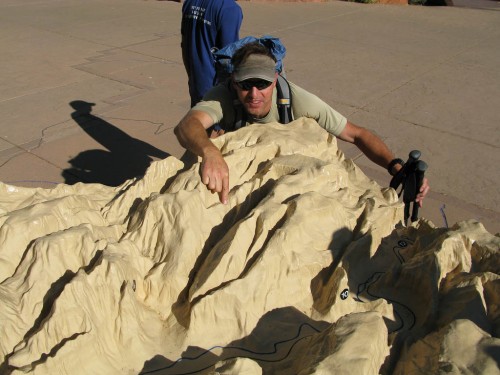
Chris pointing out Behunin canyon. To get there, we climbed the Angels Landing trail, which is the deep cleft to the viewers right of Behunin.
Virtually all my canyoneering experience is with sandstone, so it seems pretty normal to me. But, from what I have heard from other international canyoneering types, Zion is unique in that it has “dry” canyons (versus rapping down waterfalls and rivers), tons of variety, exciting technical challenges and stunning scenery. A “typical” Zion canyon will have long sections of sidewalk width canyons that go upwards for 50-150 feet, complete with bulbous rooms, keyholes and the feared potholes. Potholes are like naturally carved goldfish bowls that blend into bowling-ball smooth surfaces as they rise. As evidenced by the drowned animals that often occassion such potholes, it can be easy to get into them, but almost impossible to get out if you aren’t prepared.
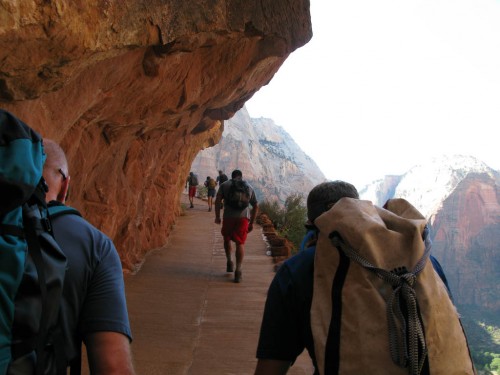
There are no short cuts to the top of Angels Landing, but plenty of switchbacks.
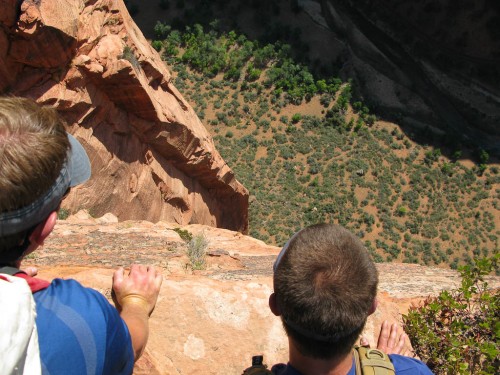
Brad and Nick look down on a climb named Lunar Ecstasy from near the top of Angels Landing. The scary formation named "The Amoeba" is still there!
As a semi-annual gathering, a group of us went down to Zion for a three day outing last Friday, Saturday and Sunday. We were rained out on Sunday, but got in a couple of good ones before that, so the trip was a great success.
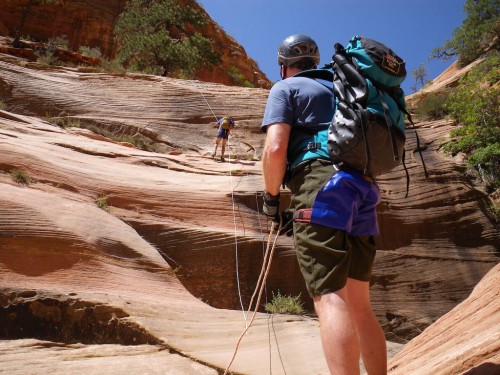
The first rappel into Behunin. Mike Ray is giving a "Fireman's Backup" to the rappeller - if he were to slip, Mike would pull on the rope, which would help increase the friction and stop the rappel.
As canyons get done more and more, they become easier. This is both a blessing a curse, as it turns some of the notorious classics into “danger walking” as a friend calls it, but it also means that it is getting harder and harder to find new canyoneering challenges.
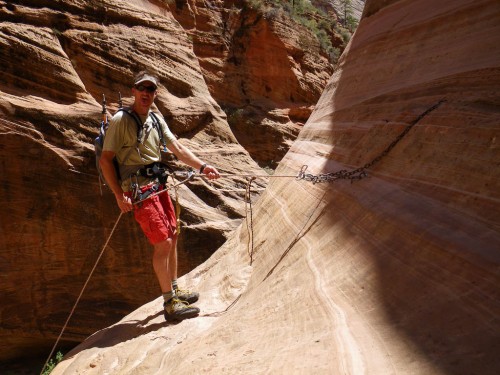
Chris rapping off of a fixed anchor. Virtually all of the rap stations in Behunin were preestablished and bomber.
Moving quickly in sandstone slot canyons is most often a matter of being quick on the set-up and tear down of rappels as some canyons may have 10-20 rappels ranging from 15′ to 200′. Because of this, there are lots of little tricks of the trade, including canyoneering rope bags, biner block rappels and using two rope bags, so one can always be sent forward so the advance team can start getting it set up while the rear guard is rapping and cleaning.
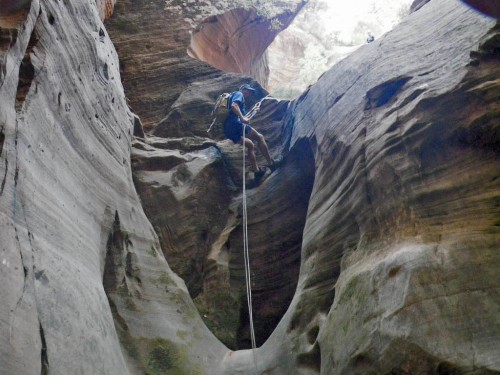
Nick sliding down a moderately long rap in Behunin.
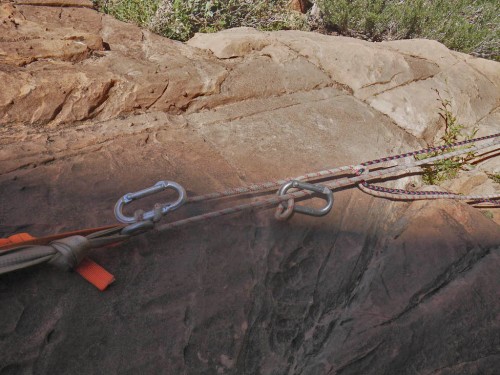
A biner-block rappel. The top biner jams up against the rap ring, while the bottom one acts as a backup in case the upper biner should break. In this case, we were rapping on the thicker line and using the thinner one as a pull cord.
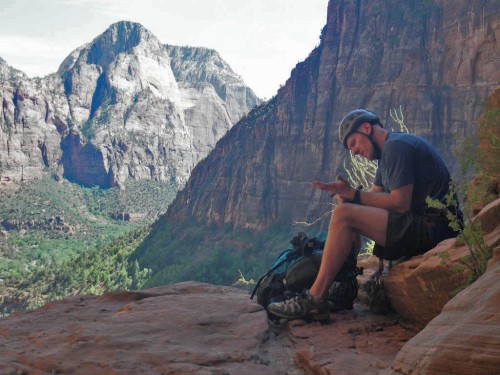
Mike Ray pulling a catcus needle out of his palm while he waits his turn on the final rappel.
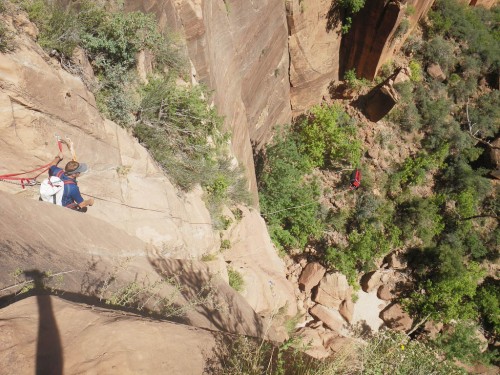
Bombs away! Brad Barlage gives the rope bag a chuck on the final 150' rap out of Behunin and into the Emerald Pools.
I was psyched to do Behunin, although it was hot (109 degrees) and almost completely dry. It is a definite collectors edition canyon.
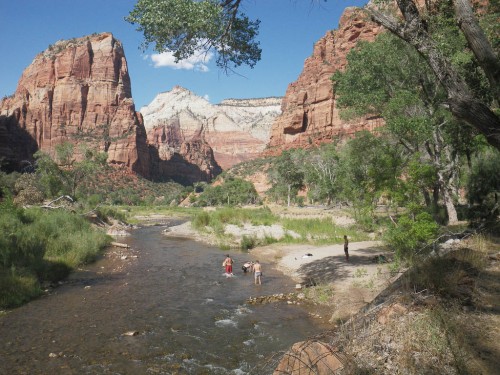
Chilly dogs at the hogs-wallow. This dip in the Virgin River after the canyon was divine.
Next on StraightChuter… the ultra classic Imlay Canyon.
___________________
Help support StraightChuter.com and go nuts at the Semi-Annual sale with up to 70% off at Backcountry.com! Click the banner below:
Category: Trip Reports










Awesome pics, looks like an amazing trip!
Andrew,
Can you explain the concept behind the biner-block rappel? Thanks.
The biner-block makes a lot of sense for canyoneering where you are doing a bunch of very short, quick rappels.
The basic idea is that you thread the rap ring, then lower down one end of the rope until it just touches the bottom. After this, you Clove Hitch a carabiner to the rope (as well as a back-up biner if you are safety minded), which then jams against the rap ring. Everyone raps on the single strand of rope, which is quick and easy, then the last person clips the rope bag to his/her harness and raps with it. At the bottom, only the bare essential amount of rope has been payed out for each rappel.
This may not seem like that big of a deal, but if you threaded a rope, found the mid-point, rapped, and pulled the rope each time (as we did on our first canyon), it takes forever when multiplied by 20, especially if you are pulling, coiling and rapping while treading water in an ice cold pool of water.
Dear Andrew,
Thanks for this interesting article, which being able to reference made ours more valuable to our readers. The page is in the “Website” box, it’s The Blog of Kevin Dolgin, Sept. 14.
Best of all possible regards,
Pat Hartman
News Editor, The Blog of Kevin Dolgin